Roman Coinage › Byzantine Coinage » Ancient origins
Articles and Definitions › Contents
- Roman Coinage › Antique Origins
- Byzantine Coinage › Ancient History
Ancient civilizations › Historical and archaeological sites
Roman Coinage › Antique Origins
Definition and Origins
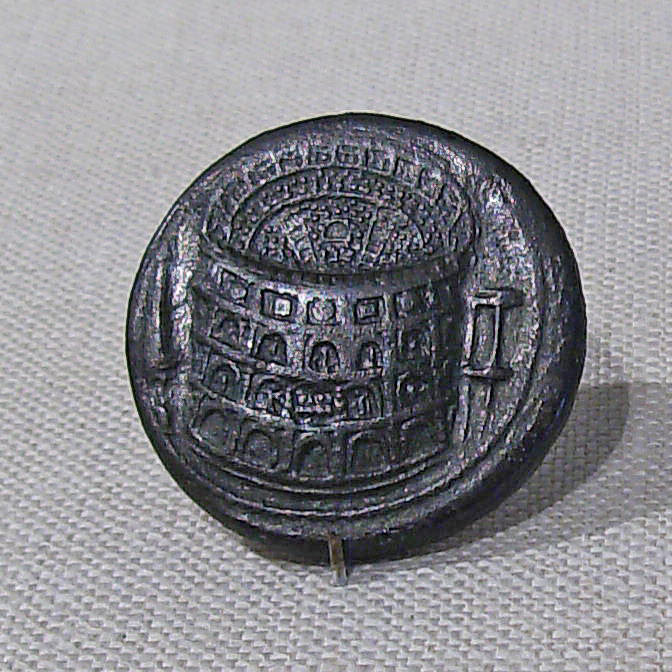
Roman coins were first produced in the late 4th century BCE in Italy and continued to be minted for another eight centuries across the empire. Denominations and values more or less constantly changed but certain types such as the sestertii and denarii would persist and come to rank amongst the most famous coins in history.
Roman coinage, as in other societies, represented a guaranteed and widely recognised value which permitted an easy exchange of value which in turn drove both commerce and technology development as all classes could work to own coins which could be spent on all manner of goods and services. Even more significantly, large and identical payments could now be easily made which made possible a whole new scale of commercial activity. Coins also had a function as a vehicle to spread the imagery of the ruling class as coinage was the mass media of the day and often carried likenesses of emperors and famous imperial monuments which would be the nearest most Romans ever got to see of them.
COINS OF THE REPUBLIC
The early Republic did not use coins but rather a system of bronze weights, the aes rude. These units were quite large as one unit was the equivalent of 324 g. or 11 1/2 oz. in weight. Despite their heaviness, this type continued to be produced up to c.218 BCE. As the Romans expanded over central Italy war booty meant coins could be produced using precious metals - gold, silver, and bronze. The first Roman coins were probably the small bronze ones of low value produced at Neapolis from 326 BCE and carried the legend PΩMAIΩN. The first silver coins were produced from the early 3rd century BCE and resembled contemporary Greek coins. These were worth two Greek drachmas and carried the legend ROMANO, later to become ROMA. Gradually, following the financial excesses of the Punic Wars, the weight of coins was reduced, as was the metal content of the bronze bars. Due to financial necessity, gold coins (aurei) were also minted, a rare event not to be repeated until the 1st century BCE.
In c. 211 BCE a whole new coinage system was introduced. Appearing for the first time was the silver denarius (pl. denarii), a coin that would be the principal silver coin of Rome until the 3rd century CE. The coin was initially funded by a tax on property but then via war booty as the wars against Carthage swung in Rome's favour. The denarius was equal to 10 bronze asses(sing. as ), each of which weighed 54 g. or 2 oz. There were other coins such as the silver victoriatus which was in weight equal to three quarters of a denarius, the quinarii, worth half of a denarius, and other bronze and gold coins but these were not always widely or consistently used. From c. 200 BCE only Rome now produced coins in Italy and the movement of troops ensured the wider circulation of Roman coinage.
IN 46 BCE JULIUS CAESAR MINTED THE LARGEST QUANTITY OF GOLD COINS YET SEEN IN ROME.
As Rome expanded and took ever more treasure from her enemies silver began to replace bronze as the most important material for coinage. This was especially so following the acquisition of the silver mines of Macedonia from 167 BCE, resulting in a huge boom in silver coins from 157 BCE. In addition, in c. 141 BCE the bronze as was devalued so that now 16 were equivalent to one denarius. It was now no longer necessary to mark coins as Roman as there were no others in Italy and by the 1st century BCE Roman coins were now also being widely used across the Mediterranean.
In 84 BCE once again the link between warfare and coinage was evidenced when Sulla minted new silver and gold coins to pay his armies, a necessity repeated by Julius Caesar, who in 46 BCE, minted the largest quantity of gold coin yet seen in Rome, outproducing the state mint in the process. Following the death of Caesar coinage was produced by the various parties fighting to succeed him but with Octavian 's victory a uniform Roman coinage was once more established.
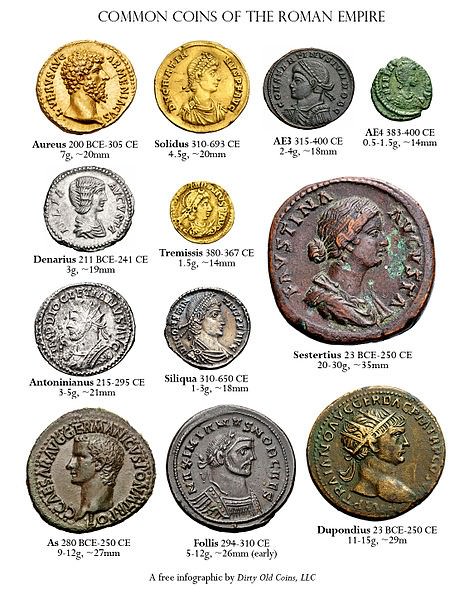
Roman Coins
COINS OF THE EMPEROR
The imagery on coins took a turn towards propaganda when Julius Caesar used his own profile on his coins, an opportunity not missed by Brutus who similarly used his own image on one side of his coins and on the other side two daggers symbolising his role in the assassination of Caesar. Augustus, naturally, followed suit but he also reformed the denominations of smaller coins and his new system would form the basis of Roman coinage for the next three centuries. Gone were the silver coins below the denarius to be replaced in 23 BCE by the brass ( copper and zinc) orichalcum sestertius and dupondius (pl. dupondii), and the as and the even smaller quadran (quarter) were now made from copper instead of bronze. The silver denarius continued as before (now valued 84 to the pound) and the gold aureii were valued at 25 denarii each and 41 to the pound (7.87 g). Coins were largely struck in Rome but a significant exception was the Lugdunum mint which started production (mostly gold and silver coins) in 16 BCE and dominated until the mid 1st century CE. Other notable mints, albeit with sporadic production, were in Lyon in Gaul and the cities of Antioch, Alexandria and Caesarea, amongst others. It is also worth noting that in the east local varieties persisted, especially low value bronze coinage.
Following the Severan emperors coin production began to proliferate throughout the empire. Hundreds of individual cities across the empire also minted their own coins and the forms of smaller denominations, in particular, were left to local authorities but in general all of these provincial varieties were convertible to Roman coin values. It was also probable that these various coins remained within their own geographical area as empire wide circulation was not guaranteed and although Rome-minted coinage was shipped to provinces it is more than likely that it remained there.
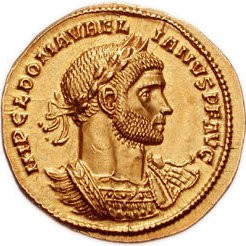
Coin Depicting Roman Emperor Aurelian
THREATS TO THE CURRENCY
Coins were continuously minted as taxation only met 80% of the imperial budget and the shortfall was met by putting more coins into circulation, the source coming from freshly mined metal. This also meant that extravagant emperors could get themselves into serious financial trouble. One solution was to reduce the weight and or the metal content of coins and so increase the possible money supply. Nero did this in 64 CE (reducing gold content by 4.5% and silver by 11%) as did Commodus, Septimius Severus and Caracalla, who produced the antoninianus which perhaps had the face value of two denarii whilst only really being worth nearer one and a half. Gradually, silver coins went from pure to 50% and then on down until they reached an all time low of just 2% silver content. There is even evidence in the later empire that low-content silver coins were deliberately given a finer silver surface to make them appear more valuable than they were. Such blatant manipulation of currency did not go unnoticed by the general population who retaliated by paying their taxes using the newer coins and keeping the older more valuable ones for savings or even melting them down.
THERE WAS A SPECIFIC BODY OF PROFESSIONALS (NUMMULARII) WHO HAD THE TASK OF TESTING SUSPECT COINAGE.
Another problem was the production of forged money, largely helped by the poor quality of the official coinage. There was a specific body of professionals ( nummularii ) who had the task of testing suspect coinage but they were overwhelmed by the flood of fake coins. The situation became even graver following the barbarian invasions of the 3rd century CE and the resulting financial pressure on the empire led to the collapse of the silver currency so that only the gold coinage and goods in kind kept the economy afloat.
From Aurelian attempts were made to improve the situation with coins being stamped to indicate their metal content: XXI or KA for 5% silver and XI or IA for 10 %. In 293 CE Diocletian continued the reforms by guaranteeing the gold content of the aurei at 60 to a pound (later renamed the solidus and which would actually outlast the empire itself), minted a new pure silver coin and a part silver bronze coin, the nummus (worth 1/7200 of a solidus). He also further reassessed values in 301 CE, restricted production to between 12 and 15 mints, and made all designs and legends the same across the empire, wherever they were minted. Constantine reversed the trend by devaluing the solidus so that 72 equalled the pound but the economy bore the change. In general, bronze coins came to the fore in the later empire with their denominations varying over time and further reforms continued so that the stability of earlier centuries was never quite recaptured and production of coinage in the West ceased around 480 CE.
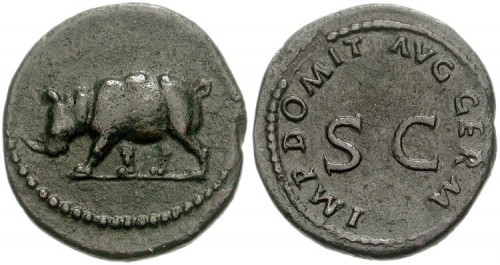
Imperial Roman Coin Portraying a Rhinoceros
IMAGERY
Images were made on coins by striking the coin by hand onto a pre-cut die placed below (obverse) and above (reverse) the blank coin. In the Republic, control of state coinage was in the hands of three junior magistrates (later to be four), the tresviri aere argento auro flando feriundo or aaaff. They often signed their issues and initially favoured such classic images as Roma, Jupiter, Mars and Victory. In the second century BCE a series of coins depicted a quadriga or four-horse chariot but from c.135 BCE the tresviri metales began to stamp references to their own family history, local landmarks, contemporary events and perhaps even their political allegiance. The representation of rulers was avoided, perhaps because on Greek coins this had been for kings and tyrants and so was not in accordance with the principles of a republic. Legends were in vertical or horizontal lines not curving around the edge and could continue on to the opposite side of the coin.
PORTRAITS COULD VARY FROM AN IDEALISED TO VERY REALISTIC REPRESENTATION DEPENDING ON PARTICULAR EMPERORS.
Imperial period coins typically have on the obverse side a portrait of the emperor - now in sole charge of the state treasury - usually in profile wearing either a radiant crown or crown of laurel leaves, or, more rarely, a member of the imperial family.Portraits could vary from an idealised to very realistic representation depending on particular emperors, the stage of their reign and changing artistic trends. After Constantine imperial portraits became increasingly standardised and a more uniform representation of the emperor regardless of individual physical characteristics became the norm. A notable exception to using the emperor was the SC ( Senatus Consulto ) stamped on Augustan coppers, perhaps signifying senatorial backing. Legends now ran clockwise around the coin, always starting from the bottom left.
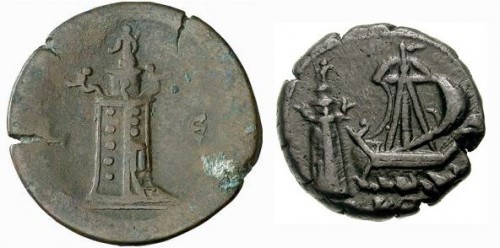
Alexandrian Coins Depicting the Lighthouse of Alexandria
CONCLUSION
In many cases, coins offer the only physical likeness of prominent personalities in the history of Rome. They also depict lost or ruined monuments and help to establish both the precise chronology of Rome and the date of other artefacts that might accompany them in archaeological finds. Coins of certain date can also help to date other less certain coins when they are found together. Coin portraits have also contributed invaluably to naming previously unidentified portrait sculpture and the distribution of coins across the empire can also reveal much about population movements, trade networks and civic identity. All of these studies continue to develop over time as ever more coin hoards are randomly discovered in out of the way places across territory once part of the Roman Empire.
Byzantine Coinage › Ancient History
Definition and Origins
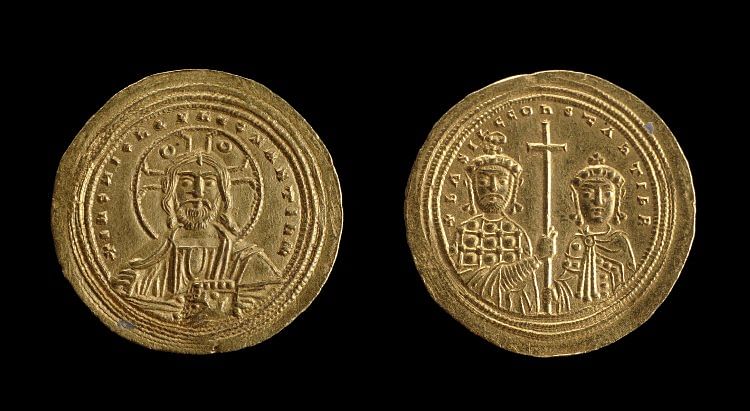
The coinage of the Byzantine Empire continued that of its more ancient predecessors and functioned as a convenient method of payment for goods and services, especially to soldiers and officials, and as a means for people to pay their taxes.Coins also continued to be the best way for a ruler to spread their image and remind their people who they owed their allegiance to. The star of the Byzantine purse was undoubtedly the gold solidus or nomisma. Introduced by Constantine I in the 4th century CE, it would reign supreme as the currency standard for 700 years, eventually to be replaced by the electrum hyperpyron from the 12th century CE.
THE NOMISMA AS STANDARD
Every Byzantine emperor minted their own coins, from either Constantinople, the capital, or in mints in major provinces such as Italy (Ravenna), Sicily ( Syracuse ), Anatolia (Antioch), and North Africa ( Carthage and Alexandria ). As in the ancient world, the value of coins in Byzantium depended on their weight and the purity of the metal used to produce them.The main coin of the Byzantine empire for 700 years was the solid gold nomisma or solidus in Latin. On its introduction in the East in 312 CE by emperor Constantine I (r. 306-337 CE), 72 nomismata were equal to one pound of gold. Thus, each example weighed 4.4 grams of pure gold and measured between 21 and 22 mm in diameter. The first versions carried a portrait of Constantine on the obverse (front) and Roman army standards on the reverse side. Further currency reforms were carried out by Anastasius I (r. 491-518 CE) whose reign actually marks the beginning of Byzantine coinage proper for numismatists.
Such was the nomisma’s longevity and reliability - Basil II was still minting them in the 1020s CE - that the worth of all other lesser-value coins made of gold, silver, or copper was measured against it. For example, the gold semissis was equal to half a nomisma, while three gold tremissis coins were worth one nomisma. Both of these coins would still be in circulation in the late 9th century CE.
ONE NOMISMA COULD HAVE BOUGHT YOU A PIG, THREE WERE NEEDED FOR A DONKEY, & FIFTEEN WAS THE PRICE OF A CAMEL.
The most common silver coin was the miliaresion, introduced in 720 CE, twelve of which were worth one nomisma. The most common copper coin was the large follis, introduced by Anastasios I (r. 491-518 CE) to improve the poor quality coins of previous emperors, which was worth very little but was useful for small transactions: 24 folles were equal to one miliaresionwhile a whopping 288 were required in exchange for a single nomisma. In terms of actual value, a labourer would have earned between five and twelve folles a day while a middle-ranking official earned some 1000 nomismata per year. One nomisma could have bought you a pig, three were needed for a donkey, fifteen was the price of a camel, and a slave with a few skills would have set you back 30 gold coins - a purchase to be made with care, clearly. Aristocrats measured their wealth in the thousands of nomismata while in the rare cases where a field army's four-year treasure chest was stolen by the enemy, such as the Bulgars in 809 CE or the Arabs in 811 CE, we know that it consisted of 80-90,000 nomismata - enough to make a tax collector's eyes water.
DEVALUATIONS
The nomisma did face brief challenges to its dominance. In the 6th and 7th century CE a less pure gold coin (22 carats as opposed to 24) was minted but did not last. A more serious challenger came in the mid-10th century CE in the form of Nikephoros II Phokas' (r. 963-969 CE) attempt to save even more gold and produce more coins. He minted a gold coin, the tetarteron, which was not only 22 carats instead of pure gold but also with one-twelfth less weight than the nomisma. In the first half of the 11th century CE, Constantine VIII (r. 1025-1028 CE) and Michael IV (r. 1034-1041 CE) both nibbled at the nomisma itself and added 5% silver to eke out more bang for their buck. This was the beginning of a slippery slope towards a much-devalued currency.
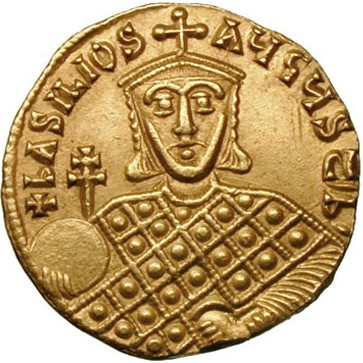
Basil I
It is debatable if emperors understood or not the long-term economic consequences of undermining their own currency, but they could not resist consistently tinkering with the gold content of their coins, reducing it when the state coffers were low and endangering confidence in the coin. Perhaps the practical necessity of the moment and the need to pay mercenary soldiers to defend the empire or make up for tax shortfalls when plagues hit the population took precedence over economic theory. As a consequence, over the whole of the 11th century CE, the gold content of the nomisma gradually went down in stages from 20 to 18 to 16 to 12 and ended up around 8 carats during the reign of Nikephoros III Votaneiates (r. 1078-1081 CE).
In the 10th century CE there were, in fact, six different versions of the nomisma in circulation and international merchants even began to favour Arab gold dinars. The state of the premier coin of the realm became so bad and prices were rising so quickly that reform was urgently needed. Consequently, Emperor Alexios I Komnenos (r. 1081-1118 CE) minted a new coin c. 1092 CE, the hyperpyron (meaning “highly refined”), which became the new standard, even if it was actually made from electrum (an alloy of gold and silver) and worth only a third of the nomisma. Alexios had sorted out the currency confusion of nobody knowing quite what the equivalents of all the coins in circulation were, but he also, rather astutely, managed to quadruple tax rates in the process. The hyperpyron did take a few decades to take off and, like the nomisma, it occasionally suffered a debasement, notably during the reign of Michael VIII (r. 1259-1282 CE), but it would survive until the fall of the empire in the 15th century CE.
IMAGERY
Coins were spread far and wide thanks to merchants and travellers so they could be used to good effect as a useful means of propaganda by rulers eager to extend their power and fame into every corner of the empire and to its neighbours. Portraits were conventionalised and did not approach the realism of, say, ancient Hellenistic or Roman coins. They usually show the person front on rather than in profile and holding a cross, sword, or sceptre. The name is helpfully written, too, which is just as well given the often poor likenesses of the time.
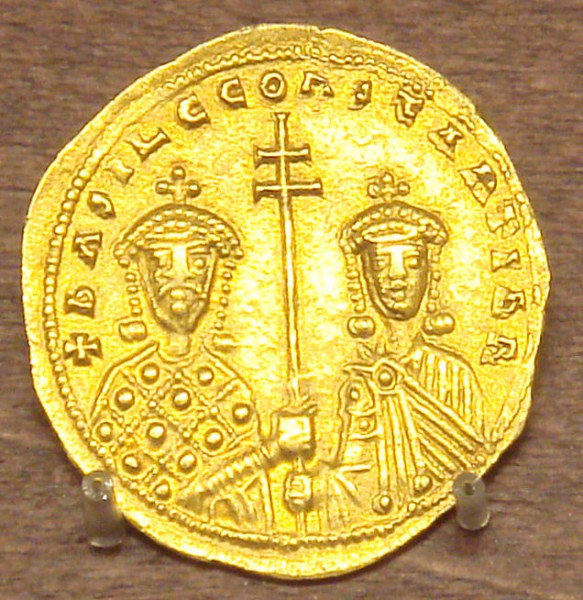
Coin of Basil II
Not only could the emperor or empress put their own face on the front of the coin - Empress Irene (r. 797-802 CE) went one better and put herself on both sides - but they could reinforce their message with other symbols of imperial power on the back.Short legends were first written in Latin, then in Latin and Greek, and then wholly in Greek from the 7th century CE.Constantine I often used the Tyche of Constantinople on the reverse of his coins. A symbol of good fortune, she sits on a throne, wears a crown with battlements and holds a cornucopia. The cross of Christianity and the Christogram became a favourite choice for many subsequent emperors. The Virgin or saints frequently appear while the coins of Alexander (r. 912-913 CE) have John the Baptist being crowned by the emperor.
JUSTINIAN II (R. 685-695 CE) WAS THE FIRST EMPEROR TO SHOW JESUS CHRIST ON COINS C. 691 CE.
Justinian II (r. 685-695 CE) had been the first emperor to show Jesus Christ on coins c. 691 CE along with the legend rexregnantium (“King of kings”). There were two versions of Jesus, one with a beard and one without, and they are similar to surviving mosaic portraits. Perhaps it is no coincidence that this pious emperor insisted that the Arab caliphate pay their tribute with these coins (which they refused and, in response to the affront, successfully invaded Anatolia to boot). By the mid-9th century CE Christ was regularly shown on the obverse of coins with the legend “Jesus Christ, King of those who rule.” The reverse sides of these coins showed the emperor being crowned by Christ, the Virgin, or a particular saint, and so reminded people that he or she was God's representative on earth.
Coin portraits were also used for political endorsements, especially when emperors had selected their chosen heir and wished to avoid a messy succession dispute after their own death. The child was often crowned as co-emperor and shown as such on coins, side by side with their parent or on the reverse side, sometimes with a sibling alongside.
CIRCULATION
For most people, the copper and silver denominations of coins would have been the only ones they handled on a daily basis.Those lucky enough to have a shiny gold nomisma in their palm probably did not keep it for very long as one of the main reasons for the state to mint coins in the first place, besides to pay soldiers and officials, was to more easily collect taxes.There were basic and ever-present taxes on land and persons/households, besides any other ingenious excuse the tax authority could come up with, such as a levy on any slave imported from a particular region. Further, all taxes had to be paid in gold coins, which was probably why the state was so vigorous in ensuring their quality.
In fact, the minting of nomisma coins was so carefully monitored and their gold content checked so scrupulously by the state that their reliability ensured even foreign states accepted and used them. The 6th-century CE merchant Cosmas Indicopleustes noted,
…every nation conducts its commerce with their nomisma, which is acceptable in every place from one end of the earth to the other…In no other nation does such a thing exist.(Herrin, 322)
The scarcity of foreign coins excavated at Constantinople is further evidence that only one coinage dominated the imperial economy. The Arab caliphate, getting over its initial dislike of the coin, was one notable user of the nomisma, where it was known as the bezant. Usually preferring it to minting their own gold coinage, they did sometimes produce their own coins which imitated, right down to the legends, those of Byzantium. Viking kings were also partial to Byzantine gold, and many coin hoards have been found across Scandinavia and northern Europe. Byzantine coins have turned up in such far-flung places as Russia, Persia, and Sri Lanka. From the 4th until the 11th century CE, and probably beyond, the nomisma was, then, the international coin of the day, and it has rightly earned from historians the unofficial title of the “dollar of the Middle Ages.”
LICENSE:
Article based on information obtained from these sources:with permission from the Website Ancient History Encyclopedia
Content is available under License Creative Commons: Attribution-NonCommercial-ShareAlike 3.0 Unported. CC-BY-NC-SA License